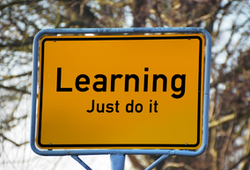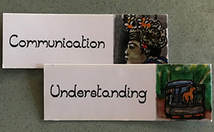 Learning. Just do it. Learning. Just do it. PlainLanguageAcademies.com Newsletter 23-01 Ready for 2023 The Plain Language Academies team is looking to the future with excitement and energy. Our French Academy, clairetsimple, is offering its first course; the much-anticipated ISO standard is coming; and, the PLAIN 2023 Conference, Connecting Cultures – building bridges with clear communication in Buenos Aries, Argentina, in September. We are constantly identifying new training needs and creating courses to address them. Let us guide you on your 2023 plain language journey. Welcome to l'Académie du langage clair et simple We welcome the first course from our French Academy, with the award-winning plain language advocates and trainers Chantale Audet and Amélie Bourret, autrementdit.ca. The Plain Language Academies are pleased to announce the new clair et simple’s online training course in French on Zoom. The training is entitled Writing Clearly to be Understood on First Reading. Students will learn what health literacy is and how to address and reinforce it with plain language. · For more information and to register on Eventbrite: https://bit.ly/3xyOfHc. · To email the L’Académie du langage clair et simple: [email protected]. · Visit their page on PLA: Académie du langage clair et simple . ********************************************************** Bienvenue à l'Académie du langage clair et simple L’Académie du langage clair et simple est heureuse d’annoncer la tenue d’une formation en ligne en français sur Zoom. La formation est intitulée Rédiger clairement pour être compris à la première lecture. Dans cette formation, vous apprendrez ce qu’est la littératie en santé et verrez comment la prendre en compte et la renforcer avec le langage clair et simple. Cette formation est divisée en quatre parties : · Le contexte d’information d’aujourd’hui · Qu’est-ce que la littératie et la littératie en santé ? · Le langage clair et simple · Les 6 étapes pour écrire en langage clair et simple: volet pratique composé d’exercices La formation est répartie sur 2 journées : · Mardi 25 avril 2023, de 9 h à 11 h 30 · Jeudi 27 avril 2023, de 9 h à 11 h Pour obtenir plus d’information et pour vous y inscrire sur Eventbrite :https://bit.ly/3xyOfHc. Pour contacter l’équipe de l’Académie du langage clair et simple: [email protected] Details are on the PLA website New help creating clear design online Our new course, Clear Digital Design is available now. It’s for non-designers who find themselves needing to make design-related decisions. Annie and Liezl, heyplainjane.com, will help strengthen your clear design skills to prepare you for working on your next project. Find our more from them or email PLA. Register here. Pick the PLA courses that will get you to your destination We are expanding our base of Core and Advanced courses to meet increasing knowledge and skill demands. Check PLA 2023 Calendar to find courses just for you. We are here to help. Get in touch if you have questions. Looking forward to connecting, PLA Team PS Our newsletters will now be posted as blogs. PLA.com Newsletter Blog 23-01 [email protected] Email to unsubscribe
0 Comments
by Nicole Watkins Campbell Editing for Plainer Legal Writing Instructor The best way to ensure your document meets readers’ needs is to test it with the audience. Even testing that is quick and cheap can give you useful information about how to improve your document. What is a test? A test can be as simple as asking a colleague or a citizen to answer one question about your text or as complicated as inviting 30 people to read your document and answer questions. Almost any test will help you make the writing better. And any test with a member of your audience will get you closer to writing that works for your readers. When should you test? Start testing as soon as you have enough material to test. Don’t wait until your document is complete unless it’s a short email. Make corrections based on feedback, and test again, if you can. The best practice is to test a couple of times, and more if the text is important and could be difficult for your readers. How should you test? Several methods will help you improve your document.
Record your results in some way:
Who should you recruit?
Testing documents internally with co-workers while you’re still writing is highly useful. You can then test a final draft with someone from outside your team. Your co-workers will likely read about as well as you do and have the same technical understanding, so you will want other perspectives on the complexity of the language and the topic. Don’t test with people who know the information in the document or people who helped you get to this point in creating this document. They will know too much about your subject area to notice what’s missing or out of place. Readability measures Your word processor or a website like Hemingway Editor will offer quick readability tests. But these long-established ways of describing how readable a text is actually don’t mean much. They were originally created to measure children’s reading skills, not documents for adults. The software counts syllables (to represent complexity in language), words and paragraphs (to represent complexity in expression) to roughly estimate reading difficulty. The resulting number claims to reflect the number of years of education a person needs to read the text. Readability measures fail in three main ways:
If your text readability score from Microsoft Word or Hemingway Editor is gets a Grade 10 or higher, you probably need to edit for clarity: many people don’t read at this level. If you test again, you will be able to see if your changes made your sentences easier to read, but you should rely on other methods to make sure your text is clear. Try setting up a simple test of a bit of writing this week. You will learn something surprising or pleasing. But you will learn something. Nicole Watkins Campbell Plain Language Academies (PLA) expandsNew courses, languages, instructors, opportunitiesPlain language knows no boundaries: so we are expanding ours to offer plain language courses in French, Spanish, and in South Africa. We want plain language to be everywhere because we know it is for everyone. 'New' is a key word for today's personal and work lives. The Plain Language Academies' team is creating more ways to share our skills and meet your growing needs for clear communication. Take advantage of current Core and Advanced courses at last year's fees. We encourage you to explore Advanced courses that tackle specific topics like clear health, legal, science, strategic planning, and online communication. New courses are coming. keep visiting us PlainLanguageAcademy.com for details and sign up for our newsletter. We are looking forward to meeting you online, sharing skills, and learning about your interests. Courses to take you forward Our courses are designed to keep your clear communication skill development focused on the future. New fees are planned for future courses. Here are brief profiles of a few courses you can consider. Clear Design Practices with Flora Gordon, (you can still sign up), explores the important role design plays in our communications and ways you can make design enhance your messages. Plain Language 2.0 and Health Literacy, never been more important. Romina Marazzato Sparano shares her expertise. Available in English (now) and Spanish (soon). Everyone is online and we need to be clear and meet their needs. Kate Harrison Whiteside brings her years of plain language use online experience to you in Creating Clear E-content. New: Implementing Plain Language as a Strategic Priority with Sarah Slabbert and Nadja Green, Plain Language Institute, South Africa. The focus of plain language is often on specific documents or pieces of communication. Implementing plain language in a systematic manner in an organization is a different challenge for executives, compliance officers, communication managers, or customer relations. This course will empower you to make your organization truly customer- or citizen-centred. See Courses for current course registration links Three good reasons to work on legal editing by Nicole Watkins Campbell We have three good reasons to work on your legal writing and editing skills this year. 1. New year–new you. New learning ALWAYS refreshes. 2. It will keep your mind busy during a potentially slow period. Learning ways to sharpen your writing or editing skills is always useful, especially if you have time to devote to deep study, like during a slow period at work. 3. It will give you little breaks during a potentially busy period. You can study at your own pace over about six weeks, even though it’s a four-week course. You can chat with other students or with me, your instructor, on issues that challenge you. In fact, I’ll help you on a thorny document, if you’d like. Learning is good for your brain and enhancing skills is good for your career. Join me for A2 Editing for Plainer Legal Writing Help us plan your future learning
The PLA team is so committed to the future of plain language, of enhanced learning, and of building connections. We are always looking for ways to improve plain language practices, skills, and projects. We keep broadening our program to meet new needs we are all facing. If you would like to see a new course, offer a new course, or access our coaching and consulting services, please get in touch. Contact [email protected]. We often think content design only applies to the text sections of our website. But, as our language becomes more visual and we, as scanners and writers, want a graphic to partner with text, clarity and readability become even more important. Using Icons Icons were developed to simplify communication, to create a clear graphic that tells the story without the need for words. But, they are still a form of communication, and understanding is required for them to be accessible and usable. They do work better and are more user-friendly when combined with text. The UK's National Health Service (NHS) has done research on icons. Yes, icons can help people understand, navigate and discover, but not all icons are universal. Their user research generated these important results:
Findings from Usertesting.com's Make Your Icons User-Friendly research are interesting. They found icon + text gets the best results. "Our study results: labels vs. no labels In our study, we found that for icons with labels, users were able to correctly predict what would happen when they tapped the icon 88% of the time. For icons without labels, this number dropped to 60%. And for unlabeled icons that are unique to the app, users correctly predicted what would happen when they tapped the icon only 34% of the time." What about links? Links are critical and require special planning around content and graphics. They get your audience to their destination. Click here is out: do not use it. Write text links, alone or within a graphic, that are clear and specific. According to this online article, Why writing links well is so important, they help site visitors find what they want, contribute to SEO, draw in scanners and increase your site's credibility. However, they can also be distracting if not done well. Read the article for tips. It’s important to view content in the big picture, content design. A picture with words can make the world of difference to your audience and your organization. PlainLanguageAcademy.com courses to help you: Clear Design Practices, with Flora Gordon, March 10, 2020 Creating Clear Online Content: start anytime. Presentations make for a competitive challenge. We prepare them, watch them and try to remember them. So, what makes one stand out? The use of simple, strong, clear, relatable language and images that connect with audiences. All these are key components of plain language. Here are ideas on how to increase the use of clear visuals and the impact of your next presentation. Integrating plain language guidelinesMarketingmag.com.au points out the weaknesses of presentations junky with charts, jargon and top heavy with text. Plain language guidelines can solve all these challenges. If you commit to clear language, concise messages and simple images that support your ideas, people will relate better and remember longer. Integrate plain language guidelines for your content and visuals to make your presentation memorable. Inspiring audiencesPresentation software is no longer exclusive. And, audiences come with high expectations. How can you meet them? In her article, ‘Choosing the right visuals’, Emma Bannister quotes research showing that 90% of what our brain processes is visual. A picture really can be worth a thousand words. The clear communication rules of simplicity apply here too. Rule 1: make sure the visual supports the text. Rule 2: design and present visuals that are audience-friendly. Rule 3: use real settings, people and locations whenever you can. Always ask, and preferably to a test audience, what viewers think of the content, the visuals, the presentation. Put people first and you’ll experience presentation power. After all, it is them we have to inspire. Impressions that lastPresenters can use clear design and presentation guidelines to enhance engagement. Gov.uk demonstrates how they committed to using simple slides to achieve memorable presentations. Choose a presentation style that supports clear information and visuals, and stick to it. Consistency in visuals is another way to have an impact.
Making an outstanding presentation relies on clarity, simplicity and strong visual impact. Set plain language guidelines, involve a test audience for feedback and be prepared to make changes to meet their needs. If you can confidently say you kept it simple, clear and really connected with visuals, you are heading for presentation success with some help from plain language guidelines. Want to learn more, take a PlainLanguageAcademy.com course. Editors Canada Conference 2018, May 25-27, Saskatoon: Plain Language Stream  When Frances McDormand said the words “inclusion rider”, during her Academy Awards Best Actress Oscar acceptance speech, it meant so much more than the two words themselves. Plain language is most often practiced around the written word, presented on paper or online. But, when you mix in speaker, setting, audience and context, words can take on a much more dynamic meaning. Defining "inclusion rider" Not everyone would have a clear understanding of the legal implications of the words “inclusion rider”, but would use their familiarity with each term individually. McDormand herself is reported to have only recently become familiar with this contract option. But, in their legal sense, in the acting profession, here is how Wikipedia defines them: “An inclusion rider or equity rider is a provision added to a contract of an actor to ensure that casting and production staff are more representative and meet a certain level of diversity…” When a production company agrees to this rider, but doesn’t meet it, consequences can result. So, you take two plain words, mix in a legal connotation, and their meaning and impact can greatly change. Plain speaking and presentation impacts Inclusion researcher Dr. Stacy Smith presented data outlining the film industry’s inequalities in a TED Talk, highlighting the point that A-listers (top actors) can lead change with inclusion riders. That’s one group McDormand was addressing in her Oscar speech. But, the impact of those two words were super-enhanced by three environmental conditions because McDormand had:
Combine plain language and clear design On paper and online, we often don’t have that kind of influence. So, plain language is all the more important to get our messages across with the intended meaning, to the intended audience, generating the intended outcome. The next time you write content for a document, website or speech, consider the impact using plain language can have, especially if it is supported by clear visuals. The combined effect of plain language and clear design can be memorable. That's what we want in our communication. PlainLanguageAcademy.com 2018 course line-up. Register now. Clear Design and Plain Language Basics begin April 1. Advanced: Editing for Plainer Legal Writing begins April 10.  Bigstock images Bigstock images Peers share top strategies for selling benefits Despite the many successes I have experienced and positive stories from my colleagues, we are still challenged by those who don't understand the benefits of plain language. After many years in the field, sketicism is still a topic peers want to talk about and seek a solution to. A recent PlainLanguageAcademy.com Google Hangout focused on how to successfully sell plain language services to skeptics. Hosted by Cathy McPhalen, thINK Editing Inc., Edmonton, the group of peers shared their experiences and expertise on ways to convert clients to this new (to some) way of connecting with audiences, by simply being clear. The discussion was lively as options were explored. "What is plain language?" "Isn't that dumbing it down?" "I don't want to lose my professional voice. That's what I'm paid for." "We've always done it this way. If it's not broke, don't fix it." Whether you are new to plain language or have been providing clear writing, editing, design and training services for some time, these protests may sound familiar. So, as a profession, what can we do to persuade skeptics clear communication is worth the investment? Here we share three proven approaches highlighted during the Hangout. 1. Educate your clients It has never been more apparent that lack of education, or understanding, can lead to sad social, political, organizational and cultural situations. Integrating a training or orientation session into your plain language proposal or project is important to get organizational support. You may have to do it to get a project started. Integrate it and get help from a plain language trainer if you need one. But, expect positive results. 2. Health check on current practices We are all somewhat resistant to change. It takes time, resources and commitment. Your client, internal or external, may say making all these changes will meet resistance and cost money. Here is a great way to turn this around. Get permission to ask some questions to help you understand their situation. Here's what our NZ colleagues at ReWrite–How to overcome daily sabotage of your brand and profit have to say about discovering what is really going on. Find out how long it takes to produce an email, a brochure, web updates or reports. How many people are involved? How many versions? Now, do a calculation: time it took x salaries = cost. Scary? Plain language can be the solution. The upfront investment in training can generate savings at many levels for the long run. 3. Words that work We are plain language professionals all helping our clients use words more effectively. Are we doing our best? What words could we use to better explain—and sell—the benefits of plain language? Do you find yourself using negative terms like 'problems', 'challenges', 'issues'? The Hangout peers put their heads together to come up with words that positively promote plain language. What do you think?
For every problem there is a solution. And, the best way to find it is with the power of peers. If you have ideas or stories on success in persuading skeptics, please post a comment or share on social media using #plainlanguage or #plainlanguageacademy. If you want to join or lead future PlainLanguageAcademy.com Hangouts, send your contact details and ideas to Kate at [email protected]. Check out Academy Course 1: Plain Language Basics, designed to increase your understanding of plain language. It can help increase your options for persuading others. The course is open to registration throughout the year. |
Let's stay connected.Subscribe to our blog for Plain Language Academy news, tips and updates. Categories
All
Archives
September 2023
|
Choose your Academy. Choose your courses. We are here to work with you.
www.facebook.com/plainlanguageacademy Twitter #plainlanguageacademy





 RSS Feed
RSS Feed